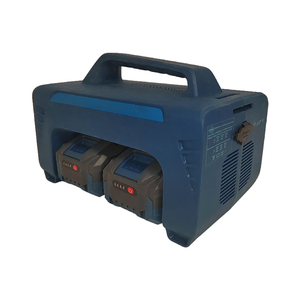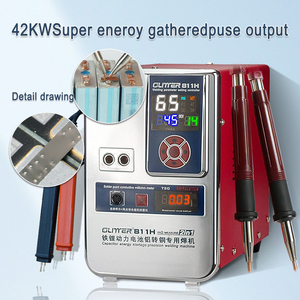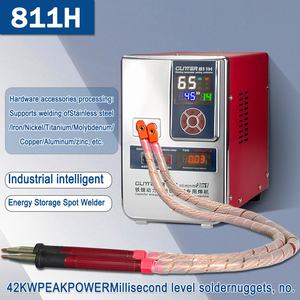
All categories
Featured selections
Trade Assurance
Buyer Central
Help Center
Get the app
Become a supplier

(9398 products available)














































Capacitor Discharge Spot Welders
The capacitor discharge spot welders use capacitors to store electrical energy and then discharge it in a quick burst to create a weld. This style of welding is best for thin sheet metals as it doesn't cause much warping or heat damage. Welders who work with materials like aluminum or galvanized steel, which can be tough to weld using other methods, often choose capacitor discharge welders. Because of their ability to produce quick, low-heat welds, these are generally used in automotive repairs and manufacturing, especially where precision and speed are crucial.
Alternating Current (AC) Spot Welders
Spot welders that operate on AC use an alternating current to perform welding operations. These welders are ideal for thicker metals and larger projects because they can generate more heat than DC welders. The AC welders also have the advantage of being able to work on more complex surfaces by heating and cooling the metal in a way that penetrates better. Construction, shipbuilding, and appliance manufacturing, where strength and durability are the main considerations, often necessitate the use of AC spot welders.
Direct Current (DC) Spot Welders
In DC welding, a direct current is used to make consistent and controllable welds between two metal surfaces. DC welders are usually more effective with thin sheets of metal because they produce focused heat at the weld site rather than spreading over a larger area. This characteristic makes them suitable for precision work in industries such as automotive bodywork, electronic components, and appliances. Companies that work with thin materials, in particular, prefer DC spot welders because of their precise control over the welding process.
Spot Welder Electrode Press Machine
This kind of welder combines welding and mechanical processes where the electrodes used for welding are also pressed on the materials to join them. These machines are good at providing strong and permanent welds in materials that require tight adhesion. They are used in mass production processes in automotive manufacturing, sheet metal fabrication, and construction. The electrode pressing feature helps minimize resistance at the weld point, which improves weld quality.
Automotive Industry
The battery spot welder is crucial in the automotive industry for bodywork. These welders are used to join metal sheets in making car frames and other structural components. One of the most important features of these welders is their ability to make strong yet lightweight welds. This is an advantage for the automotive industry because it ensures that although the vehicles weigh less, they still have structural integrity. Also, since they operate on batteries, these spot welders are more portable, which is useful in places that ordinary welders cannot reach.
Manufacturing of Appliances
In home appliances like refrigerators, washing machines, and ovens, battery spot welders play another important role. These welders put together metal casings and other components in these industries. It's possible to carry out these operations without being connected to an electrical outlet thanks to the convenience of battery-powered tools. This adds mobility to the work, especially in large production areas. Using spot welders also ensures that the welds are much more energy efficient.
Construction and Shipbuilding
Battery spot welders are utilized in construction and shipbuilding, particularly for tasks involving thin sheet metal. In shipbuilding, for instance, they are employed in the construction of hulls and other interior structures where spot welding is needed to ensure strength and durability. The light and portable design makes them easy to use on large and difficult-to-reach surfaces. Construction workers also use these welders for their sheet metal roofing and cladding work. Their efficacy ensures that these projects are completed within a short time.
Electronics and Electrical Equipment
In the electronics industry, battery spot welders are important in assembling products like circuit boards and battery packs. These welders are employed to weld together thin metal sheets or to join nickel strips to lithium-ion battery cells. Since the customer electronics business usually involves thin materials, a battery-operated spot welder for metal is suitable for this environment. Also, because it is portable, it can provide the mobility required to perform these delicate operations in several locations within a production setup.
Metal Fabrication and Repair Shops
Spot welders for batteries are common in metal fabrication and repair shops. In these businesses, the welders are mostly used to repair damaged metal structures or to fabricate new ones. Their portability and convenience allow mechanics and fabricators to carry out welding work in several environments. It is also possible to use these welders in field repair jobs where access to power outlets is restricted. Strong, heat-resistant welds are also made by and efficient battery spot welders.
Output Current
The output current can vary between welders and is generally between 5,000 and 10,000 amperes. The weld must be made thicker for optimal current output. A welder with a higher current output will be needed for thick materials.
Voltage
Typically, these devices operate on voltage between 5 and 30 volts. These voltages are used to guarantee efficient battery operation for spot welding. Voltage levels must be compatible with welding tasks to avoid insufficient or excessive heat that can warp or damage the metal.
Electrode Pressure
Many welders have adjustable electrode pressures that are normally set between 20 and 100 psi. This ensures that the electrodes perfectly touch the metal surfaces to give the required weld. Correct pressure is paramount to achieving good electrical contact and minimizing distortion.
Welding Speed
Welding speeds are affected by the model, but generally range from 1.5 to 7.5 inches per second. Production requirements will determine how fast a particular spot welder should operate. For instance, higher speed is desirable in commercial applications.
Electrode Material
Most models on the market use copper or copper alloys for electrodes. These materials are chosen because they have superior heat and electricity conduction. The material should ideally have a higher melting point in order to reduce wear during the welding process.
Cooling System
Battery spot welders possess either forced air or water cooling systems that help maintain temperatures during extensive use. Welders with better cooling mechanisms ensure longer continuous operations without overheating. This is particularly important in high-demand commercial environments.
Power Source
These spot welders are powered by different battery types, with lithium-ion and lead-acid batteries being the most popular choice. While lithium-ion batteries have a better power-to-weight ratio and recharge more easily, lead-acid batteries are usually more affordable. For consistent welding performance, the battery chosen must have sufficient capacity and discharge rate.
Assembly of the Electrode Arms
The first step in setting up a battery spot welder is to attach the electrode arms to the main body of the device. The welding tips must be fitted to the ends of the arms. Having them secured properly will ensure that the welding pressure created will be even. This is important because any variation can cause the weld to be weak or too strong in some areas.
Positioning the Electrode
Once the electrodes are in position, the next fitting will be to adjust the distance between the two electrodes. It must be stated that these electrodes must be around one to two millimeters apart. The distance will depend on the thickness of the metal that will be welded. Welds on thinner materials will require smaller gaps, while thicker metals will need larger spaces.
Powering the Device
The spot welder's battery or main power source must then be connected once the electrodes have been set up. If a lithium-ion battery is used, it should be secured in place to prevent movement during operation. For lead-acid batteries, make sure the connections are clean and tight as this will ensure that there are no interruptions while the device is functioning. After the power source has been connected, the welder must be allowed to charge fully before use to achieve optimal performance.
Control Settings
The final step is to adjust the control settings of the spot welder. The settings required will mostly depend on the metal being welded. The voltage and current will have to be adjusted according to the thickness of the material. For consistent spot welding, the timing and pressure must be set correctly.
Preparation of Materials
For spot welding to take place, two metal sheets must first be aligned properly. The surfaces that will be joined together must be cleaned to eliminate any contaminants. Proper clamp or fixture must then secure the sheets. This preparation ensures that even pressure is applied during the welding.
Adjusting Electrode Pressure
Next, welder electrodes are positioned above the metal sheets. The pressure of the electrodes must be adjusted to ensure that they are making good contact with the materials. The pressure should not be too high because it can cause damage to the metal; it should not also be too low because it can result in insufficient current flow.
Setting Power Output
The output level of the spot welder must then be set. The power level should be adjusted to the metal's thickness while operating the machine. The metal can easily burn through if the power is set too high. Setting it too low will lead to insufficient heat generation for a strong weld. This is why using a test piece to find the correct balance is needed.
Initiating the Weld
Electrodes must be pressed down to make contact with the metal. The power button should be pressed to activate the welding process after this is done. Holding the weld until the machine indicates that the process is completed is important. This will usually take just a few seconds. After the weld cools, the electrodes can be removed.
Inspection
Welds must first be examined before proceeding with any further operations. Look for signs of robust adhesion between the materials. Any irregularity, like gaps or excessive warping, must be addressed immediately.
Regular Inspection
Welds should always be examined to check for any signs of weakness or wear. This also helps identify problematic areas that will require immediate fixing. For frequent inspections, users can utilize a checklist to determine what items need repair. Colors can also be used to identify different spots that need attention.
Electrode Maintenance
Electrodes should be cleaned often to eliminate metal deposits and contaminants that can affect their performance. Welder tips should also be shaped regularly to ensure the proper amount of pressure is made at the weld point. Usually, a flat surface is needed for ideal welding. When these tips become worn out, they should be replaced instantly. Some of the common signs that it's time for an electrode to be replaced include poor weld quality, uneven surfaces, and excessive heat generation.
Cooling System Checks
This is to ensure that the cooling systems are functioning properly and no overheating occurs. It is important to always check for leaks or blockages in either the water or air cooling system. It is a must that coolants be replaced frequently to maintain optimal temperatures. Overdue coolant might damage the spot welder, leading to costly repair bills.
Battery Care
Since the spot welder mainly operates on battery, proper care has to be taken to maintain its lifespan and ensure it offers optimal performance. Lead-acid batteries need to be checked for corrosion, and the connections must be cleaned often. Lithium-ion batteries, on the other hand, must be stored in cool, dry areas to prevent the risk of over-heating. Additionally, users will have to ensure that the battery is fully charged before use. A low-charge battery will create weak welds that sometimes can affect the quality.
Software and Hardware Upgrades
If there are any upgrades or patches available for the software that controls the spot welder, they should be installed frequently. Upgrading the hardware can help improve its efficiency and functionality. Technicians must be aware of the latest components and upgrades that are out there. This helps ensure that the welder always performs its best.
Use Proper Materials
Using the right type of metal and electrode materials is important for the production of quality welds. In other words, compatible materials will help reduce stress and produce a compelling joined metal. Irrespective of whether the materials are of a different type or thickness, the spot welder can handle them more efficiently, as long as they are compatible.
Electrode Maintenance
To ensure quality welds, electrodes have to be maintained. This means they have to be cleaned and replaced when needed. When electrodes are worn out or dirty, they will not provide the proper amount of heat and pressure required at the weld point. This may cause weak or inconsistent welds, ultimately leading to structural risks. More importantly, always ensure that these electrodes are maintained. Regular inspections make them work well for a longer time.
Heat Management
These welds normally generate a lot of heat. This means users must have to monitor the temperature during the process. When this heat accumulates too much, it may damage the surrounding metal, warp the material, or even weaken the weld itself. This, however, can be minimized by using proper cooling systems and techniques. These include taking breaks between welds, using water-cooled electrodes, and ensuring that there is good ventilation around the machine.
Regular Testing
Conducting non-destructive tests on existing welds will go a long way in ensuring their quality. These can include visual inspections, ultrasonic testing, or X-ray examination. These tests help locate any defects that can cause future failures. Having these tests done regularly means that they can be addressed before they compromise safety.
Safety Gear Usage
Users must wear safety gear suitable for risks associated with spot welding. This means wearing gloves, goggles, and protective clothing to avoid any injuries may be caused by sparks or heat. Welders, for instance, produce a lot of light that can hurt the eye, so wearing protective gear is needed.
Ventilation
Proper spot welding ventilation is crucial to minimize hazardous fumes from metal burning. Just as the fumes have to be properly exhausted, there also has to be proper intake of fresh air to replace the air that has been exhausted. A small fan can be used to vent it outside while simultaneously bringing in fresh air from outside. This will create a flow that moves the fumes outside while bringing fresh air inside.
Equipment Inspection
Before using a spot welder, it is always important to inspect it for any signs of malfunction. Cables that have wear and tear, loose connections, or damaged electrodes can pose great risks to the user. Trouble-free spot welders should be maintained and repaired, but those that have major internal problems should be discarded instead of risking the safety of the person.
Emergency Preparedness
Having an emergency plan is also important for any welding workshop or space. This means having first aid kits to treat mild injuries that can occur during the spot welding process and having fire extinguishers handy in case there's an outbreak of fire.
A1: A battery spot welder is a machine used to join two metal pieces together by applying intense heat and pressure at their meeting point. The work is done by electric current passing through two electrodes to create a "spot weld." In simple terms, it uses electricity and pressure to glue metals at one point very, very hot.
A2: Battery spot welders are strongest on thin sheets of steel and stainless steel. They work well with regular car body metal. They also handle aluminum and copper, but these tricky metals take extra care. Aluminum can warp from heat, and copper gets too hot on regular welders. For these two, special settings or different methods might be needed.
A3: Battery spot welders are great for portability! They don't need to plug into an outlet, so they're easy to move around. They can even go to job sites or remote places far from power sources. Some models are compact enough to hold with just one hand. While many are cart-sized for bigger jobs, their wireless operation lets users get welding almost anywhere.
A4: The main advantage of a battery-operated spot welder is its portability. It doesn't need to be plugged into an outlet, so it's easier to move around and can be used in remote locations. Battery spot welders are also often more compact and lightweight, making them easier to transport. However, AC and DC welders generally provide more power for larger or more intense welding jobs.
A5: They are similar in that both types of welders join metal by applying heat to a specific point. But they differ in how they generate the heat. A battery spot welder uses electric current through electrodes to create heat at the weld site. An arc spot welder uses electric arcs between electrodes and the metal to create heat. The battery spot welder is more portable and easier to move around, while the arc spot welder typically plugs into a power source and may offer more power for larger jobs.